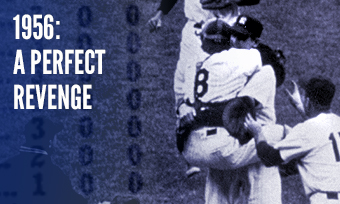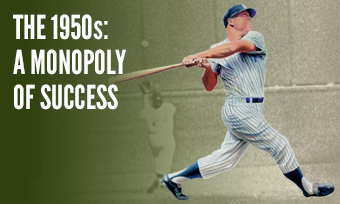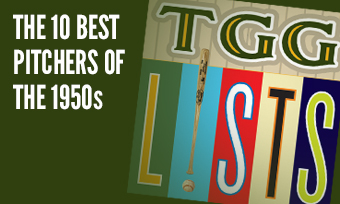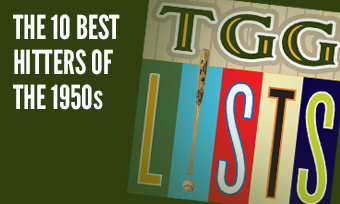The Yearly Reader
Leaders and Honors, 1956
Our list of baseball’s top 10 hitters and pitchers in both the American League and National League for the 1956 baseball season, as well as the awards and honors given to the game’s top achievers of the year.
The National League’s Top 10 Hitters, 1956
Bold type in brick red indicates league leader.
1. Duke Snider, Brooklyn
Key Numbers: .292 average, 112 runs, 33 doubles, 43 home runs, 101 RBIs, 99 walks, 26 intentional walks, .399 on-base percentage, .598 slugging percentage.
Snider took public heat for telling a magazine that he only played baseball for the money, but the Dodgers weren’t complaining; to them, he was worth every penny.
2. Willie Mays, New York
Key Numbers: .296 average, 101 runs, 171 hits, 27 doubles, 8 triples, 36 home runs, 94 RBIs, 20 intentional walks, 40 stolen bases, 10 caught stealing.
Mays became the first National Leaguer—and only the second major leaguer—to collect 30 homers and steals each; he came within four homers of making it 40-40.
3. Frank Robinson, Cincinnati
Key Numbers: .290 average, 122 runs, 166 hits, 27 doubles, 6 triples, 38 home runs, 83 RBIs, 20 hit-by-pitches.
After barely making it through Class-A ball the year before with an ailing arm, a healthy Robinson busted out as an instant star in Cincinnati.
4. Hank Aaron, Milwaukee
Key Numbers: .328 average, 106 runs, 200 hits, 34 doubles, 14 triples, 26 home runs, 92 RBIs.
Still yet to be feared as a big-time power threat, Aaron momentarily settled for the stigma of being one of the game’s most complete players, winning his first of two career batting titles.
5. Eddie Mathews, Milwaukee
Key Numbers: .272 average, 103 runs, 37 home runs, 95 RBIs, 91 walks.
Ten of Mathews’ homers were blasted within a 16-day period in midsummer, but they wasn’t enough to get him to 40 overall for a fourth straight season.
6. Joe Adcock, Milwaukee
Key Numbers: 137 games, .291 average, 38 home runs, 103 RBIs.
Prone to big days, Adcock—who a few years earlier clubbed four homers at Brooklyn—had the season’s highest RBI count in a NL game with eight against the Giants on July 19.
7. Stan Musial, St. Louis
Key Numbers: .310 games, 87 runs, 184 hits, 33 doubles, 6 triples, 27 home runs, 109 RBIs, 75 walks.
Musial remained as durable as he was effective, continuing a streak of consecutive games played that would be break a NL record in 1957.
8. Ted Kluszewski, Cincinnati
Key Numbers: 138 games, .302 average, 91 runs, 35 home runs, 102 RBIs, 22 intentional walks.
“Klu” was one of four Reds to hit three home runs in a game in 1956; only one other major leaguer outside of Cincinnati (Washington’s Jim Lemon) could claim a hat trick during the season.
9. Stan Lopata, Philadelphia
Key Numbers: .267 average, 96 runs, 33 doubles, 7 triples, 32 home runs, 95 RBIs, 75 walks.
Something of a one-year wonder, the part-time catcher became full-time Phillie by providing back-up at first base and set a team record for homers by a right-handed batter that would stand until Dick Allen surpassed it in 1966.
10. Ken Boyer, St. Louis
Key Numbers: .306 average, 91 runs, 182 hits, 30 doubles, 26 home runs, 98 RBIs.
The young third baseman, in his second season, emerged as worthy, long-sought protection for Stan Musial while earning the first of seven All-Star roster spots.
The American League’s Top 10 Hitters, 1956
1. Mickey Mantle, New York
Key Numbers: .353 average, 132 runs, 188 hits, 22 doubles, 5 triples, 52 home runs, 130 RBIs, 112 walks, 10 stolen bases, .705 slugging percentage.
The year Mantle would call his greatest represented the only triple crown triumph by a switch-hitter.
2. Minnie Minoso, Chicago
Key Numbers: .316 average, 106 runs, 172 hits, 29 doubles, 11 triples, 21 home runs, 88 RBIs, 86 walks, 23 hit-by-pitches.
In the first year that the AL made batting helmets mandatory, Minoso probably felt more at ease getting plunked at league-high rates.
3. Al Kaline, Detroit
Key Numbers: .314 average, 96 runs, 194 hits, 32 doubles, 10 triples, 27 home runs, 128 RBIs, 70 walks.
In a worthy encore to his impressive rookie breakout of the year before, Kaline set career highs in triples and RBIs.
4. Ted Williams, Boston
Key Numbers: 136 games, .345 average, 28 doubles, 24 home runs, 82 RBIs, 102 walks, 11 intentional walks, .479 on-base percentage.
The big victory for the Red Sox is that they were able to get Williams close to a full season; his 136 games played were the most of any of his final nine seasons (1952-60).
5. Yogi Berra, New York
Key Numbers: .298 average, 93 runs, 29 doubles, 30 home runs, 105 RBIs.
The veteran catcher had some of the most impressive numbers of his Hall-of-Fame career, but a shot at MVP #4 never hit the target as teammate Mickey Mantle was just too good. (Berra finished second in the vote.)
6. Charlie Maxwell, Detroit
Key Numbers: .326 average, 96 runs, 163 hits, 28 home runs, 87 RBIs, 79 walks.
Maxwell couldn’t squeeze into a monopolized Boston outfield of Ted Williams, Jackie Jensen and Jimmy Piersall, but his first-year effort in Detroit elated a Tigers team that had plenty of vacancy.
7. Jackie Jensen, Boston
Key Numbers: .315 average, 80 runs, 182 hits, 23 doubles, 11 triples, 20 home runs, 97 RBIs, 89 walks, 11 stolen bases, 23 grounded into plays.
For the only time in a six-year period, Jensen failed to knock in 100 runs; he might have gotten there had Ted Williams, typically hitting in front of him, not been reduced to pinch-hitting with a foot injury.
8. Harvey Kuenn, Detroit
Key Numbers: .332 average, 96 runs, 196 hits, 32 doubles, 7 triples, 12 home runs, 88 RBIs.
Never known for his power, Kuenn muscled out a career-high 12 homers, with five of them belted in July alone.
9. Larry Doby, Chicago
Key Numbers: 140 games, .268 average, 89 runs, 24 home runs, 102 RBIs, 102 walks.
Doby was traded to the White Sox for two common players before 1956, but made more than good on the Chicago side of the deal.
10. Mickey Vernon, Boston
Key Numbers: 119 games, .310 average, 28 doubles, 15 home runs, 84 RBIs.
The 38-year-old hit machine was practically the only player of a nine-man trade between the Red Sox and Senators who did anything of worth for his new team.
The National League’s Top 10 Pitchers, 1956
1. Warren Spahn, Milwaukee
Key Numbers: 2.78 ERA, 20 wins, 11 losses, 3 saves, 39 appearances, 35 starts, 20 complete games, 281.1 innings, 52 walks.
Aging but hardly fading, Spahn embarked on a six-year run winning 20 games in each.
2. Lew Burdette, Milwaukee
Key Numbers: 2.70 ERA, 19 wins, 10 losses, 39 appearances, 35 starts, 6 shutouts, 256.1 innings, 52 walks.
Take away his appearances against the NL pennant-winning Dodgers and (oddly enough) fifth-place Phillies, and Burdette’s league-leading ERA plummets to 1.91.
3. Don Newcombe, Brooklyn
Key Numbers: 3.06 ERA, 27 wins, 7 losses, .794 win percentage, 36 starts, 5 shutouts, 268 innings, 46 walks.
After Newcombe, no pitcher would again win the Rookie of the Year, Cy Young and MVP awards until Justin Verlander. Newk also put together a career-best streak of 39.2 consecutive scoreless innings.
4. Johnny Antonelli, New York
Key Numbers: 2.86 ERA, 20 wins, 13 losses, 41 appearances, 36 starts, 258.1 innings.
A bounce-back season for Antonelli on a team in search of one; after his 20 wins, no one else on the Giants won more than seven.
5. Bob Friend, Pittsburgh
Key Numbers: 3.46 ERA, 17 wins, 17 losses, 3 saves, 49 appearances, 42 starts, 314.1 innings, 85 walks, 18 intentional walks, 25 grounded into double plays.
Friend went from part-time starter to full-time workhorse-plus, making the most starts of any NL pitcher between 1917 (Pete Alexander) and 1963 (Don Drysdale, Jack Sanford).
6. Bob Buhl, Milwaukee
Key Numbers: 3.32 ERA, 18 wins, 8 losses, .692 win percentage, 38 appearances, 33 starts, 216.2 innings, 105 walks.
Don’t blame Buhl for Brooklyn’s return to the World Series; eight of his 18 wins came against the Dodgers.
7. Sal Maglie, Brooklyn
Key Numbers: 2.87 ERA, 13 wins, 5 losses, .722 win percentage, 26 starts, 5 shutouts, 191 innings.
Once hated by Brooklyn fans for knocking down Dodgers batters wearing the uniform of the Giants, all was forgiven as “The Barber” set up shop at Ebbets Field and threw a no-hitter against the Phillies on September 25.
8. Hersh Freeman, Cincinnati
Key Numbers: 3.40 ERA, 14 wins, 5 losses, .737 win percentage, 18 saves, 64 appearances, 0 starts, 108.2 innings.
It may have all been about the hitting for the Reds in Cincinnati, but Freeman (14 wins, 18 saves) was just as instrumental in lifting the Reds above .500 for the first time in 11 years.
9. Brooks Lawrence, Cincinnati
Key Numbers: 3.99 ERA, 19 wins, 10 losses, 49 appearances, 30 starts, 218.2 innings.
All but a sure bet to become the Reds’ first 20-game winner in nine years, Lawrence became largely relegated to bullpen duty in September; he later claimed his manager, Birdie Tebbets, did it on purpose because he didn’t want to see a black pitcher get to the milestone.
10. Gene Conley, Milwaukee
Key Numbers: 3.13 ERA, 8 wins, 9 losses, 31 appearances, 19 starts, 158.1 innings.
More strong supporting work from the once-and-future basketball pro, performing the reliable fifth man in the Braves’ rotation—especially when on the road (7-1 record, 2.02 ERA).
The American League’s Top 10 Pitchers, 1956
1. Whitey Ford, New York
Key Numbers: 2.47 ERA, 19 wins, 6 losses, .760 win percentage, 30 starts, 225.2 innings, 13 caught stealing/picked off, 31 grounded into double plays.
Ford continued to be the AL’s toughest nut to crack for both hitters and baserunners, 11 of whom were picked off base.
2. Herb Score, Cleveland
Key Numbers: 2.53 ERA, 20 wins, 9 losses, .690 win percentage, 33 starts, 5 shutouts, 249.1 innings, 129 walks, 263 strikeouts, 11 wild pitches.
The flame-throwing southpaw got better with each start, winning half of his games after August 1. But fate would not be on Score’s side in the years to come.
3. Early Wynn, Cleveland
Key Numbers: 2.72 ERA, 20 wins, 9 losses, .690 win percentage, 35 starts, 277.2 innings.
Wynn continued to win early, late and almost every time in between. Along with Score and Bob Lemon, Wynn would be part of Cleveland’s third trio of 20-game winners in a six-year period; only five times would #20 be reached by an Indians pitcher over the next 51 years.
4. Bob Lemon, Cleveland
Key Numbers: 3.03 ERA, 20 wins, 14 losses, 3 saves, 39 appearances, 35 starts, 21 complete games, 255.1 innings, 28 grounded into double plays.
Lemon won 20 games for the last time; as he turned 36 at season’s end, the injuries began piling up and he never recovered. Within a few years he would embark on a second career as coach/manager.
5. Frank Lary, Detroit
Key Numbers: 3.15 ERA, 21 wins, 13 losses, 41 appearances, 38 starts, 20 complete games, 294 innings, 116 walks, 12 hit-by-pitches, 26 grounded into double plays.
A year after no one won 20 games in the AL, Lary led a sextet of throwers who reached the milestone in 1956.
6. Tom Brewer, Boston
Key Numbers: 3.50 ERA, 19 wins, 9 losses, .679 win percentage, 32 starts, 244.1 innings, 112 walks.
Middle-of-the-road starter Brewer slowed up his curve and thus sped up his game to All-Star status.
7. Jack Harshman, Chicago
Key Numbers: 3.10 ERA, 15 wins, 11 losses, 34 appearances, 30 starts, 226.2 innings, 102 walks.
Five years after he slugged 47 homers in the minors, Harshman realized success at the major league level as a pitcher.
8. Billy Pierce, Chicago
Key Numbers: 3.32 ERA, 20 wins, 9 losses, .690 win percentage, 33 starts, 21 complete games, 276.1 innings, 100 walks.
Pierce finally got a win total (20) deserving of his ERA.
9. Tom Sturdivant, New York
Key Numbers: 3.30 ERA, 16 wins, 8 losses, 5 saves, 32 appearances, 17 starts, 158.1 innings.
The first of two fleetingly glamorous years in pinstripes for the second-year pitcher, who gradually moved from the bullpen to the rotation as the season progressed.
10. Johnny Kucks, New York
Key Numbers: 3.85 ERA, 18 wins, 9 losses, 31 starts, 224.1 innings, 33 grounded into double plays.
The pitcher who four times between 1955-59 won exactly eight games jumped to 18 in 1956—and might have made it to 20 had he won at least two of his final four starts.









